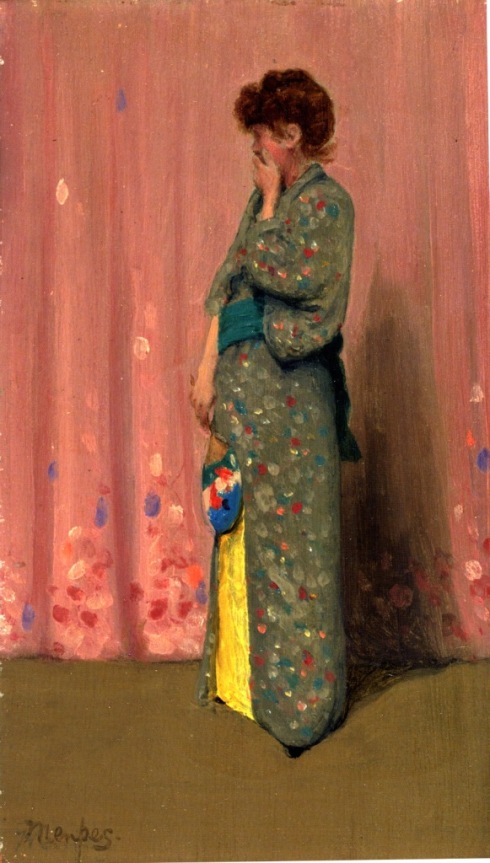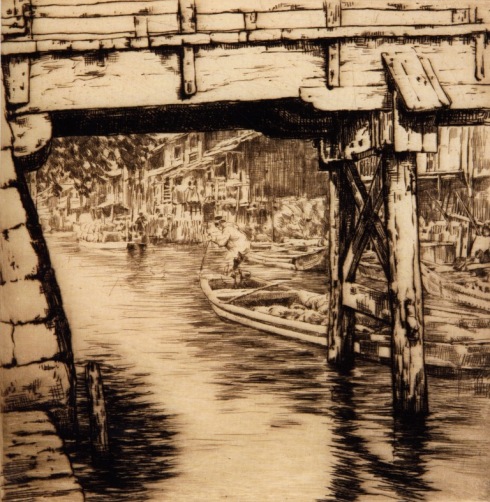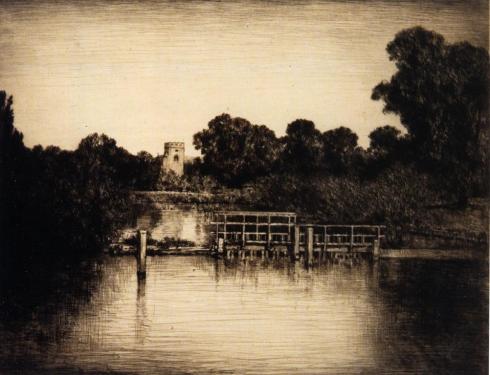This week’s guest blogger is Marianne Collins, former Librarian at the J____ Street Library, now Head Archivist at the European Institute of Esoteric Studies, She presents an episode of library history with a few local connections.
The Victorian psycho-geographer Henrietta Cole-Elliott is best known for her two London tours “West London walks”(1895), and “Burial grounds of the secret city” (1900) but before she wrote either of those she published a study of folklore, “Follies and fancies of old London” (1885). There was a copy in the Reference store but I had never looked inside. The folklore collection wasn’t usually of much use to my customers. It was my assistant K who brought it up for a visitor. The next day she drew my attention to a page the customer had photocopied. This was the relevant paragraph:
“At the Lion Tavern, Old Brompton, in the days before May Day, a dress and bonnet were hung before the inn sign. A girl no more than twenty years of age was chosen for the honour of wearing the garments on the appointed day. She was carried around the garden at the rear of the inn amid much celebration and then she would enter the stand of trees at the rear of the property where she would spend the night alone. In the morning she would return to the inn and deposit the dress and bonnet in a chest prepared for the purpose. It was commonly believed that on some occasions the girl who returned was not the one who left.”
K said to me, what does that remind you of?
![Red Lion Tea Gardens Brompton 1782 2537]()
It was one of the watercolours in the Fletcher collection, “pictures by an unknown lady”. There were 20 pictures, mostly of locations in west London in the 1830s or 1840s. (The unknown lady remains unidentified but my predecessor had suggested it was Lavinia Fletcher, the traveller who was the first European to visit the city of Khotan. ) The artist sometimes left copious notes on the backs of her pictures and in this case there were a few lines of handwriting.
“One Tarlington, a disgraced man and a scholar forced a girl to be carried from his premises tied like a captured animal into his woods where she was exchanged for a woman from Faery who served him in all his designs.”
K had a second question. “Did you know this?” She produced a card from the manuscripts index: Elliott-Cole, Henrietta: papers relating to publications. 765301. “She wanted to see that too.”
“Did you show her the painting?”
“No, I only thought of it this morning. There was something odd about her, really.”
There often is, I thought. We went down to the archives room to look at the manuscript box, and the accessions register. While I unpacked the box K told me about the woman.
” I thought she was wearing some sort of costume. It was a bit like those steampunks we met at Olympia. No goggles or anything, but she was wearing this old looking dress, brown, and a hat, sort of shading her eyes. Then she noticed me looking at the hat and she took it off. She was gorgeous actually, like a model or something. And she had a nice smile…”
“But?”
“There was something strange there0. She was just too charming, I suppose, as if she was making me like her.”
“Did you like her? You made every effort to help her.”
“That was the annoying thing. I did like her. But afterwards I couldn’t think why.”
The accessions register told me that Mrs Cole-Elliott had deposited a varied bunch of material: papers, drawings, photographs, a travel diary and some odd objects. The date of the deposit was 1936, so she had evidently lived to a good age. I resolved to look for more about her – maybe there had been a biography. As I sorted through the material a kind of story emerged. The ceremony at the Lion Inn had evidently preoccupied Mrs Cole-Elliott long after she had first written about it. She came to believe the event was far from the harmless folk ritual she had first imagined it to be. She found a longer narrative in a letter from a Miss Fletcher in which it was clear that the girl selected for the May Day ceremony was usually unwilling and that she was bound to the pole on which the dress was hung when she was paraded around the garden to the delight of “a jeering mob”.
From a hand drawn map it was clear that when the Lion was pulled down in the 1850s the house built on the grounds was C—- Lodge. The Fletcher family owned the Lodge but never lived there much. In the 1880s it became a school, or women’s training college, under the auspices of yet another Fletcher. This was the time when John Ruskin started the May Day Festival at Whitelands College. That was intended as a Christian event with some influences of old England. The High Mistress at C— Lodge was so taken with the Whitelands Festival that she instituted a version of her own, the Queen of the Lillies.
Mrs Cole-Elliott believed some influence had flowed the other way, and that pupils from C____ Lodge later attended Whitelands. She notes that the costumes in this picture resemble what is know about the ceremonies at the Lion
![010c Flower girls 1903]()
Although she admits these young women look particularly harmless and free of occult influence. She was not so sure about other images.
![009a Masque 1902]()
This is the first of a series of pictures in which she picks out certain individuals in which she is interested.
She had done all she could to find out about the exact nature of the celebration for the Queen of the Lillies to little avail. She evidently believed that there were little or no Christian elements. But nor were there any stories about missing girls or unusual practices. She found one account from, 1887,in the diary of Amelia Jones, a girl from the north of England. Amelia’s friend Isabel was pleased to be chosen as Queen of the Lillies and even more pleased when the High Mistress presented her with a special dress for the occasion. Amelia reports that Isabel went “into the trees” at the end of the ceremony accompanied by herself and another friend , but she expresses surprise that anyone could spend the whole night in the narrow stand of trees against the rear wall, all that was left of the wood at the rear of the Lion. (Other accounts speak of a substantial copse of trees in the garden )Nothing more of any interest happens. Isabel returns in the morning, gives the dress back and life goes on. Amelia never mentions her again.
Mrs Cole-Elliott was able to verify that Isabel Morgan never took up teaching or any other profession. A woman of that name took part in the Chelsea Festival of 1908. Cole-Elliott seems have been convinced that the Festival was a cover for some kind of esoteric activity. But she presents no actual evidence.
![Episode 10 group]()
There is a question mark on the back of this over-exposed picture.
And a series of them on this one,
![episode 6 Nuns]()
The manuscript box also contains this photograph, evidently from one of the summer schools run by the dancer Margaret Morris.
![Plate 34]()
Mrs Cole-Elliott’s note on the back of the photograph reads: “right,standing”.
Again, she implies that Morris’s choreography had some ritual significance. She records meeting Morris herself on the occasion when the dancer took a party of people around the then derelict house of Dr Phene. I suppose she must have asked about Isabel Morgan.
Henrietta Cole-Elliott proved herself to be a tenacious woman. She instituted correspondence with Arthur Machen and W B Yeats. She attended the ceremonies in Redcliffe Gardens of the splinter group of the Golden Dawn formed by Dr Falk. Was she looking for more information, or was she hoping to meet someone?
One of the last pictures in the collection is a photograph of this anomorphic painting by Austin Osman Spare:
![AOS - Woman with red hair 1930s - Copy]()
“None of the women in these pictures look alike to me”, said K.
“Well that would be the point, wouldn’t it? The Fairies or the Fair Ones of the Fae or whatever you want to call them are supposed to be able to adopt a pleasing guise if they wish. Remember that scene in True Blood?”
“I stopped watching that. I prefer Lost Girl.”
We agreed to differ on that point. There was some talk about Hemlock Grove after that, and then she asked the crucial question.
“So our woman Henrietta believed that Isabel Morgan found her way into a wood which didn’t exist any more and was exchanged with a fairy?”
“That would be about it.”
C— Lodge closed as a school in the early 20s. The house became a private residence and eventually was used occasionally for guests of the Cyanography Institute. Today, part of the Institute’s archive is kept there, below the empty apartments. I found a picture of it from the early 1900s and it looked pretty grim.
![C Lodge 1902]()
The photographer, Jubal Freeman, had his back to the copse of trees at the rear, but I suppose he had no idea it might be of more interest than the house.
I decided to go there and made arrangements with the archivist, a lively woman with a sense of humour bu no interest in the history of the site. As we toured the empty rooms she made a joke about the upstairs rooms being reserved for the Galactic Ambassador, something I once heard said about a building in Bloomsbury owned by the Theosophists. She was very interested in talking about security and CCTV as there had just been a break-in. Some petty cash was taken from the office, a laptop and, from the archive room a box containing the dress worn by Queen Isabel in 1887. I wondered if a human being might really want to go to another plane of existence and what a fairy, if there were such things, would do with her immortal life in our world, and whether she might eventually get bored and want to go home, and how she might achieve that. But it was no good talking to the no-nonsense archivist about that. I thought I might share my thoughts with K later.
![DSC_4521]()
I suspected that we would never know the end of this story, but one Saturday morning I went down to the basement to look at the CCTV for the day of the woman’s visit. The new camera system was quite expensive, installed as a result of a violent incident. It was possible to zoom in quite closely. I found the woman in the brown dress and hat. I only had K’s description to go on but the woman seemed more remarkable than K had said. She wasn’t beautiful at all to my mind. She was thin and her clothes were baggy on her. Her features were sharp and narrow, her eyes too large. Her hair was very fine. She smoothed it with her hand after removing the hat. You could clearly see that her ears were pointed. So were her teeth when she smiled at K. Perhaps the glamour, if that’s what is was, didn’t work on video. Whatever her intentions had been, or were still, I was glad she hadn’t made contact again. I never told K about what I saw.
Books by Henrietta Cole-Elliott:
Follies and fancies of old London (Wilder,1889)
West London walks (Black, 1895)
Burial grounds of the secret city (Black, 1900)
Esoteric churches of London (Morchester House, 1905)
Visitors from Faery (novel) (Cyanography Press, 1922)
Techniques of astral travel (Cyanography Press 1925)
Biography: City traveller: the life of Henrietta Cole-Elliott by Maria Fletcher (Hermes Press, 1938)
Postscript
Despite Mrs Cole-Elliott’s assertions The Whitelands College May Queen Festival has never been associated with any form of occultism.
C_____ Lodge was recently the subject of an extensive conversion which included a series of basements. The building collapsed as a result of the underground development and the work has been suspended pending the outcome of a court case.
The painting by Austin Osman Spare is from Phil Baker’s excellent biography of Spare. AOS: the life and legend of London’s lost artist (Strange Attractor,2012). I don’t normally do promotion here but I must mention that Phil Baker will be taking part in an event at Kensington Library: “Lord of strange deaths: the life and work of Sax Rohmer, creator of the arch-villain Fu Manchu” along with London historian Antony Clayton (Subterranean City ) and Gary Lachman, biographer of P D Ouspensky and author of many books on occult matters. It’s on Thursday December 11th. Further details here. I will certainly be there.
Finally, as I always say at this time of year normal service will be resumed next week. DW
![]()
![]()







































































































































































































































































